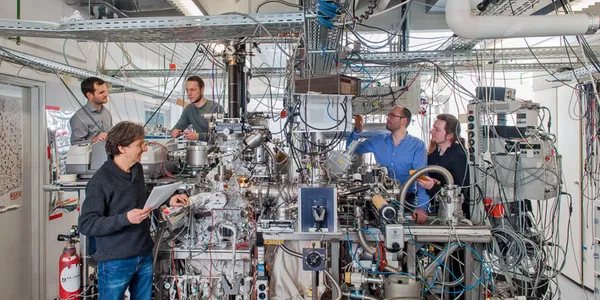Reactivity, Enantioselectivity and Electronic Properties of Cluster-Assembled Catalysts

Elucidating the size-dependent evolution of the chemical and physical properties of finite material aggregates is among the outstanding challenges of modern science. In this respect, metal and metal oxide clusters play a dominant role, having discrete quantized energy levels, specific structural and chiral motifs and exhibiting unique dynamical characteristics. For larger aggregates, it is found in many instances that the deviations of the properties from the bulk limit scale with the size of the aggregate. However, for sufficiently small sizes, e.g. clusters, the dependence of the material properties on size become non-scalable, that is, they can no longer be deduced or extrapolated from those known for larger sizes.
In this project, we aim at controlling chemical reactions by changing cluster size, chemical composition, charging, dimensionality and chirality. This opens up new avenues for the design of cluster catalysts with distinct and tunable chemical activity, stereoselectivity and enantioselectivity. This approach requires the atom-by-atom preparation of the cluster catalysts. Metal and metal oxide clusters are synthesized in the gas phase by laser evaporation cluster sources and subsequently mass-selected by a quadrupole mass spectrometer and deposited on various well characterized support materials. Chiral clusters are either prepared in the gas phase and separated spectroscopically or by deposition onto chiral surfaces. The cluster catalysts are then characterized by surface sensitive spectroscopies, like Auger electron spectroscopy (AES), ultraviolet photoelectron spectroscopy (UPS), or metastable He* impact electron spectroscopy (MIES).
Cluster reactivity, stereoselectivity and enantioselectivity are studied by means of temperature programmed reaction (TPR) and pulsed molecular beam reactive scattering (p-MBRS) coupled with electron impact, two photo ionization, and circular dicroism (CD) ion mass spectrometry. The transients from p-MBRS are modeled by using kinetic simulations. For obtaining more details of the involved reaction mechanisms, polarization-modulated infrared reflection absorption spectroscopy (PM-IRAS), MIES and UPS are used to characterize the bonding and activation of the cluster adsorbed reactants and intermediates. Whenever possible, the reactivities are related to structural cluster motifs and electronic structure and the experimental findings are compared to ab initio calculations. In another type of experiments, the clusters are deposited on various catalytic support materials (glassy carbon, microreactors, TEM grids, …) and the cluster reactivities are measured ex situ. The reactions of interest are oxidation, hydrogenation, dehydrogenation, polymerization and ring opening reactions.
Collaborations
- Prof. U. Landman (Georgia Institute of Technology, Atlanta)
- Prof. I. Chorkendorff (Technical University of Denmark, Copenhagen)
- Prof. C. Langhammer (CHALMERS, Sweden)
- Prof. J. Feldmann (LMU, Germany)
- Prof. Y. Suchorski (TUW, Austria)
- Prof. J.-M. Basset (KAUST, Saudi-Arabia)
- Dr. C. Henry (Director CINAM-CNRS, Luminy)
- Prof. M. Moseler (Universität Freiburg)
Project Funding
- Deutsche Forschungsgemeinschaft (DFG)
- Deutsch-Französische Hochschule (DFH)